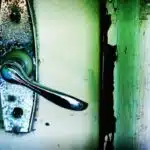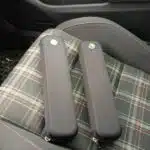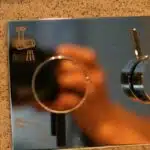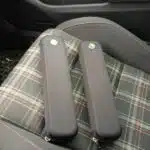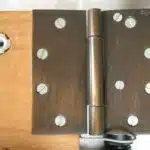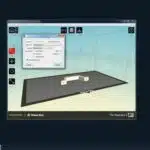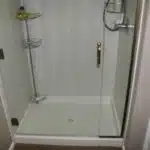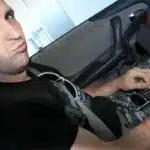Lever door handles are a common feature in modern homes and commercial buildings, providing an easy-to-use and aesthetically pleasing option for opening doors. However, over time, these handles may become loose due to wear and tear, making it difficult to open or close the door. A loose lever door handle can be annoying and inconvenient, but fortunately, it is a problem that can be easily fixed with some basic tools and knowledge.
In this article, we will provide you with a step-by-step guide on how to fix a loose lever door handle. Whether you are a homeowner or a handyman/handywoman looking to help others with their home repairs, this guide will equip you with the necessary skills to tighten up those pesky loose handles. So whether you’re dealing with a bedroom door that won’t stay shut or an office door that needs fixing before the next meeting, read on to learn how to fix your loose lever door handle like a pro!
Identifying A Loose Lever Door Handle
A loose lever door handle is a common household problem that can be frustrating and inconvenient. It can cause the door to stick or become difficult to open, which can be especially troublesome if it’s an entrance or exit door. Identifying the cause of the loose handle is important before attempting to fix it.
The most common cause of a loose lever door handle is wear and tear over time. The screws that hold the handle in place may have become loose due to repeated use, causing the handle to wobble or jiggle when pulled. Another possible cause is improper installation or maintenance. If the handle was not installed correctly, it may become loose over time, or if it wasn’t properly maintained, dirt and debris can accumulate inside the mechanism causing it to malfunction.
To avoid making common mistakes when identifying the cause of a loose lever door handle, it’s important to examine all parts of the mechanism carefully. Check for any visible signs of damage or wear and look for any missing or broken pieces that may need replacing. Avoid jumping straight into fixing the problem without first determining its source as this could lead to further damage and more costly repairs down the line.
Now that you know what causes a loose lever door handle, it’s time to gather the tools you’ll need to fix it.
Gathering The Tools You’ll Need
To fix a loose lever door handle, you’ll need to gather some tools. You’ll want to make sure you have the right tools on hand before you begin the repair process. Choosing appropriate tools is crucial for a successful repair job. The most important tool in this case is a Phillips screwdriver. You may also need pliers or a wrench depending on your specific door handle.
Once you’ve gathered your tools, it’s time to ensure proper safety measures are in place. Before you start any repairs, make sure that the area around the door is clear of any obstacles or tripping hazards. Ensure adequate lighting and ventilation for the space where you’ll be working. Finally, be mindful of sharp edges and moving parts while handling the door handle.
Remember that safety should always come first when attempting any repairs on your own. By choosing appropriate tools and ensuring proper safety measures are in place, you can avoid injury and damage to your door handle. With these precautions in mind, it’s time to move on to removing the cover plate and accessing the interior of the door handle mechanism for further inspection and repair if necessary.
Removing The Cover Plate
- To begin disassembling the cover plate, use a Phillips screwdriver to remove the screws holding it in place.
- Once the screws are removed, use a flathead screwdriver to gently pry the plate from the door.
- Carefully slide the plate away from the door to expose the inner mechanism.
- Check to ensure all screws have been removed before attempting to further disassemble the plate.
- Inspect the inner mechanism to determine the cause of the loose lever handle.
- Look for signs of wear and tear or any other damage that may be causing the handle to be loose.
Remove Screws
Removing the cover plate of a loose lever door handle can be an easy task to accomplish. The first step is to remove the screws that are holding the cover plate in place. This can be done by using a screwdriver that is the right size for the screws.
To begin, locate the screws on the cover plate and use the screwdriver to turn them counterclockwise until they come out completely. It’s important to keep track of these screws so they don’t get lost or misplaced during this process. Once you have removed all of the screws, gently pull off the cover plate from the door.
After removing the cover plate, you may find that some of the hardware has become loose or damaged. If this is the case, finding replacement hardware may be necessary before reattaching everything. With new hardware in hand, simply follow steps in reverse order: reattach any loose pieces, position cover plate back on door and finally secure with screws.
Gently Pry Plate
When it comes to removing the cover plate of a loose lever door handle, there are a few different methods that can be used. One option is to gently pry off the plate from the door. This method requires some caution and care to avoid causing any damage to the hardware or the door itself.
To start, locate any small gaps or spaces around the edges of the cover plate. These areas can be used as leverage points for prying off the plate. Use a flat tool, such as a putty knife or screwdriver, to carefully work your way around the edges of the plate, applying slight pressure in an upward direction.
It’s important to be gentle and patient during this process to avoid bending or breaking any of the hardware components. With some careful maneuvering, you should be able to remove the cover plate without causing any damage. Once removed, you can access and address any issues with loose or damaged hardware underneath.
Inspect Inner Mechanism
In addition to removing the cover plate of a loose lever door handle, it’s also important to inspect the inner mechanism. This step allows you to identify any underlying issues that may be contributing to the problem. Common causes of a loose handle include worn-out screws or spindle, damaged springs, or misaligned hardware.
To inspect the inner mechanism, start by removing any visible screws or fasteners that are holding the handle in place. Once removed, carefully remove both sides of the handle from the door. You should now have access to the internal components of the mechanism.
Inspect each component for signs of wear and tear, damage, or misalignment. Look for any broken or missing parts that may need replacing. Tighten any loose screws and ensure that all parts are properly aligned. By taking these preventative measures, you can avoid future issues with your door handle and keep it functioning smoothly for years to come.
Remember that regular maintenance and inspection are key to keeping your door handles in good working condition. By taking proactive steps to address any issues as soon as they arise, you can save yourself time and money in the long run while ensuring that your home remains secure and functional.
Tightening The Screws
After successfully removing the cover plate, it’s time to check the handle’s stability by twisting and turning it. In most cases, a loose lever door handle is caused by loose screws that need tightening. Think of these screws as the foundation of a house – if they’re not secure, the entire structure becomes unstable. The same applies to a door handle; if the screws are loose, the handle will wobble and potentially fall off.
To fix a loose lever door handle, you’ll need a wrench to tighten the screws. Make sure to use the correct size wrench for your screws; using the wrong size can strip them and cause more damage. Once you have the right tool, gently tighten each screw until they’re snug but not too tight. Over-tightening can also cause damage, so be careful not to apply too much force.
Before replacing the cover plate, give the handle another twist test to ensure it’s stable. If it still feels loose, repeat the process of tightening each screw until you’re satisfied with its stability. Remember that fixing a loose lever door handle takes patience and attention to detail – rushing through this process could result in more damage or an even looser handle. With some effort and care, you can easily fix your door handle and improve your home’s security.
- Feel confident in your ability to fix household issues
- Save money on hiring a professional handyman
- Enjoy peace of mind knowing your home is secure
- Take pride in maintaining your own home – Improve your DIY skills and knowledge for future projects.
Replacing The Cover Plate
After identifying that the lever handle is loose, the next step would be to remove the cover plate. The cover plate is a decorative piece that hides the screws holding the handle in place. To remove it, use a screwdriver to unscrew the screws and gently lift off the cover plate. Be careful not to damage it as it may affect its appearance.
Once you have removed the cover plate, take a moment to clean any dirt or debris that may have accumulated underneath it. Cleaning instructions will depend on what type of material your cover plate is made of. For example, if it’s metal, you can use a soft cloth and mild soap solution to wipe away any grime or fingerprints. If it’s plastic, avoid using harsh chemicals as they may cause discoloration or even melting.
Now that you have removed and cleaned the cover plate, you can replace it with either an identical one or choose from various decorative cover options available in hardware stores. Decorative covers come in different shapes, sizes, and finishes that can add an aesthetic appeal to your door handle while also hiding any imperfections underneath. Just ensure that whatever option you choose fits well with your current door handle mechanism.
Before moving on to checking for proper fit, let’s summarize what we’ve done so far: we have identified and removed the loose lever handle’s cover plate; cleaned any dirt or debris present; and replaced it with either an identical one or a decorative option. Now let’s move on to ensuring everything fits snugly before tightening any screws back into place.
Checking For Proper Fit
To continue with fixing a loose lever door handle, the next step is to measure the thickness of the door. This is an important step as it helps in choosing the right replacement parts for your door handle. Measuring door thickness is quite easy and can be done using a tape measure or a ruler.
Once you have measured the thickness of your door, it’s time to choose the right replacement parts. The market offers various sizes and types of screws, so it’s crucial to select ones that match the size and type of your handle. Look for screws that are longer than what you currently have as they will provide a better grip on the handle and help prevent any future looseness.
In addition to selecting suitable screws, make sure to choose a replacement handle that fits your door’s style and aesthetic. Don’t forget to consider how often this door is used when making your selection as some handles are more durable than others. With proper measurements and careful consideration in choosing replacement parts, you’ll be able to fix your loose lever door handle in no time!
To adjust the latch of your newly fixed lever door handle, take hold of the latch bolt located on the edge of the door and turn it clockwise or counterclockwise until it properly aligns with its corresponding hole in the strike plate on the frame. Test out your adjustment by closing and opening the door several times until it latches securely without any resistance or dragging sounds. Once everything seems to be working correctly, tighten any remaining loose screws from previous steps for added security against future wobbling or loosening.
Adjusting The Latch
To adjust a loose lever door handle, it is essential to check the latch mechanism. Often, the problem lies with the misaligned latch, which causes the handle to become loose. To adjust the latch, you need to remove the faceplate from the edge of the door and locate two screws that hold the latch in place. Loosen these screws and then move the latch up or down as needed until it aligns with the strike plate.
Once you have adjusted the latch, test it to ensure that it works correctly. You should be able to turn the handle without any resistance or looseness. If you notice any problems, such as difficulty turning or an excessively tight grip on the handle, you may need to make further adjustments. Keep adjusting until you achieve a smooth operation.
Adjusting the latch is only one part of fixing a loose lever door handle; another critical step is lubricating the mechanism. Over time, dirt and debris can accumulate in the lock cylinder, leading to jamming and other problems. Lubricating regularly helps prevent this issue while also extending your lock’s lifespan. To lubricate your lock mechanism, apply a small amount of graphite powder or silicone spray into keyholes and other moving parts of your lock for smoother operation.
With proper adjustment and lubrication, your loose lever door handle will work like new again! Remember not to force anything while making adjustments as this could cause further damage. In our next section we will discuss how to lubricate your door handle mechanism to ensure optimal performance over time without causing any harm during application.
Lubricating The Mechanism
To lubricate the mechanism of a loose lever door handle, you will need to apply lubricant to the moving parts. This will help reduce friction and allow the handle to turn more smoothly. You can use a silicone-based lubricant or a graphite powder for this task.
Before applying any lubricant, make sure the handle is in the unlatched position. Then, carefully remove the cover plate and spray or sprinkle the lubricant onto the moving parts of the mechanism. Be careful not to over-apply as this could cause excess buildup and potentially lead to further problems down the line. Once done, test the tightness of the handle by turning it back and forth a few times.
If you find that applying lubricant did not fix your loose lever door handle issue, it may be time to tighten the set screw. This is a simple process that involves using an Allen wrench to tighten the screw located on one side of the handle. In our next section, we will guide you through this step-by-step process so you can have your door handle working like new in no time!
Tightening The Set Screw
As a handyman/handywoman, the next step in fixing a loose lever door handle is to tighten the set screw. This screw is usually located on the underside of the lever and holds it onto the spindle. If it becomes loose, it can cause the entire handle to wobble or come off completely.
To tighten the set screw, you will need a pair of pliers. Hold onto the lever with one hand while using the pliers to turn the screw clockwise with your other hand. Be sure not to overtighten as this could damage the internal mechanism of the handle. Once tightened, test the handle to ensure that it is secure and functioning properly.
If tightening the set screw does not solve the issue, there are alternative solutions that can be tried. One option is to replace any worn components within the handle such as springs or washers. Another option is to lubricate any moving parts within the handle with a silicone-based lubricant. If all else fails, it may be necessary to replace the entire door handle assembly.
With the set screw tightened or alternative solutions attempted, it’s time to move on to reassembling the handle. Ensure that all components are properly aligned before securing them back into place.
Reassembling The Handle
Once the loose lever door handle has been disassembled, it’s time to reassemble the parts. The reassembling process requires careful attention to detail and accuracy, as even minor errors can lead to further damage or a poorly functioning handle. In this section, we’ll discuss some techniques for reassembling the handle and common mistakes to avoid.
Firstly, take note of how the parts were removed during disassembly. This will help in identifying where each part should go during reassembly. Start by inserting the spindle into the latch assembly, ensuring it is properly aligned. Next, attach the exterior handle onto the spindle and secure it with screws. Then insert the interior handle onto the spindle and secure it with screws as well.
Another crucial step is to ensure that all of the parts are tightened securely but not over-tightened. Over-tightening can cause stress on certain components, leading to breakage or misalignment of parts in future use. Refer to manufacturer instructions for recommended tightening torque specifications if available.
To summarize, here are some helpful tips for successful reassembling:
- Take note of how parts were removed during disassembly
- Ensure proper alignment when inserting spindle into latch assembly
- Secure exterior and interior handles with screws
- Avoid over-tightening of screws
Common mistakes include incorrect alignment of parts leading to difficulty in operating handle or causing damage upon usage due to metal rubbing against each other. Another mistake is tightening screws too much which could strip them or cause irreparable damage on important components.
Now that we have gone through some basic reassembling techniques and common mistakes to avoid let’s move on to testing the handle’s functionality.
Testing The Handle’s Functionality
To ensure that your loose lever door handle is fixed properly, it’s important to test its functionality. This step is crucial in order to avoid any further damage or unnecessary maintenance work. To do this, simply turn the handle and ensure that it operates smoothly and securely.
One way to test the durability of your newly fixed door handle is by conducting a stress test. This can be done by repeatedly turning the handle with force to see if it can withstand pressure without becoming loose again. If you find that the handle becomes loose after several rounds of stress testing, then there may be an underlying issue that needs to be addressed.
In addition to stress testing, there are also preventative maintenance tips you can implement to keep your door handles functioning properly for longer periods of time. Regularly lubricating the moving parts of your door handles with oil or grease can help prevent wear and tear, which will ultimately extend their lifespan. Additionally, checking for loose screws and tightening them as necessary can also prevent future issues from occurring.
To troubleshoot common issues with your door handles, there are several steps you can take. These include examining the latch mechanism for any signs of wear or damage, ensuring that the strike plate is properly aligned with the latch bolt, and checking for any obstructions that may be preventing the latch from engaging with the strike plate. By taking these steps, you’ll be able to identify any potential problems early on and address them before they become major issues.
Troubleshooting Common Issues
A loose lever door handle can be compared to a limp handshake. It is uninviting and lacks the necessary firmness that one would expect from a functional door handle. Oftentimes, it may seem like an insignificant issue, but it can lead to further damage if left unfixed.
Common causes of a loose lever door handle include worn-out screws, hinge misalignment, or a faulty spindle. Thankfully, there are several DIY solutions that you can try before seeking professional assistance. Firstly, tighten the screws and see if that solves the problem. If not, check for any misalignments in the hinges and adjust them accordingly. If all else fails, consider replacing the spindle which connects the two handles.
Fixing a loose lever door handle on your own can be rewarding and cost-effective rather than calling for professional assistance right away. However, there are times when you might have to seek professional assistance due to complex issues or lack of experience in handling such problems by yourself. Knowing when to call for help is crucial in maintaining safety and preventing further damage to your home.
It’s important to remember that as handy as you may be around your home, there are some situations where calling in a professional is necessary. In cases where the problem is more complicated than expected or requires special tools and expertise, seeking professional assistance is advisable. By recognizing when to call professionals for help with your loose lever door handle issues, you’ll save time and money while ensuring safety in your home.
Knowing When To Call A Professional
As a handyman/handywoman, it is important to acknowledge when a job requires the expertise of a professional. Fixing a loose lever door handle may seem like an easy task, but if done incorrectly, it can lead to more serious problems in the future. Common mistakes include over-tightening screws or using the wrong type of lubricant. These mistakes can cause damage to the internal mechanism of the handle and result in costly repairs.
If you have attempted to fix your loose lever door handle without success, it may be time to consider calling a professional. A skilled locksmith or handyman will have the necessary tools and knowledge to diagnose and repair any issues with your door handle. While this may seem like an added expense, it can be a cost-effective solution in the long run as they will ensure that the problem is fixed correctly and prevent any future damage.
Preventing future loose handle problems starts with proper maintenance. Regularly inspect your door handles for signs of wear and tear such as loose screws or worn-out parts. Lubricate moving parts regularly using silicone-based lubricants rather than oil-based ones which can attract debris and dirt over time. In addition, make sure to tighten all screws properly but avoid over-tightening as this can cause damage too. With these simple steps, you can prolong the life of your door handles and save money on repairs down the road.
Preventing Future Loose Handle Problems
Preventive measures can be taken to avoid future problems with loose lever door handles. The first step is to ensure that all screws are tightened properly during installation. This includes the screws on both sides of the door, as well as any additional screws used to attach the latch and strike plates.
Another long term solution is to upgrade the quality of the door handle itself. Investing in a higher quality lever handle can prevent looseness due to wear and tear, which is common with lower quality handles. Additionally, choosing a handle with a solid construction rather than hollow will provide more stability over time.
Regular maintenance of the door handle is also important for preventing future issues. Cleaning the handle regularly with a mild soap and water solution can help remove dirt and grime that may cause friction or corrosion over time. Lubricating the moving parts of the handle with a silicone-based lubricant will also ensure smooth operation and reduce wear on the mechanism.
By taking these preventive measures, homeowners can avoid having to deal with loose lever door handles in the future. A little bit of effort now can save time and money down the road by avoiding costly repairs or replacements. In the next section, we will discuss some final thoughts on maintaining your door hardware for optimal performance.
Conclusion
As a handyman/handywoman, it is essential to know how to fix a loose lever door handle. This problem can be frustrating and even dangerous if left unattended. The good news is that most cases of loose lever door handles are simple to fix, and you don’t need any special skills or tools to get the job done.
Common causes of loose lever door handles include worn screws, damaged spring mechanisms, or simply a misaligned latch. To fix this issue, start by tightening any loose screws using a screwdriver. If the screws are already tight but the handle is still wobbly, try lubricating the spring mechanism with silicone spray. In more severe cases where the latch is misaligned, you may need to adjust it using pliers or call in a professional.
Preventative maintenance tips for your lever door handles include regular cleaning and lubrication of moving parts. This will help prevent wear and tear on the mechanism and ensure smooth operation for years to come. Additionally, always use caution when handling your door handles as excessive force can cause permanent damage.
By following these simple tips, you can have your loose lever door handle fixed in no time. Remember that preventative maintenance is key in avoiding future issues with your doors and handles. So take care of your home’s hardware today!
Conclusion
A loose lever door handle can be a nuisance and compromise the security of your home. Identifying the problem is the first step, followed by gathering the necessary tools such as a screwdriver and pliers. Removing the cover plate allows access to tighten any loose screws that may be causing the issue. Replacing the cover plate completes the repair.
Troubleshooting common issues may help solve more complex problems, but it’s important to know when to call for professional assistance. Preventing future loose handle problems can include regular maintenance and checking for wear and tear.
As a handyman/handywoman, fixing a loose lever door handle is an easy task that can save you time and money in the long run. With these simple steps, you can confidently tackle this repair on your own. Remember to troubleshoot common issues and take preventative measures to ensure your door handles remain secure. Don’t let a loose handle compromise your safety – fix it today! So, are you ready to take on this DIY project?
Image Credits
- “16B_1 1955 DeSoto Rare Firedome Convertible” by bsabarnowl (featured)



